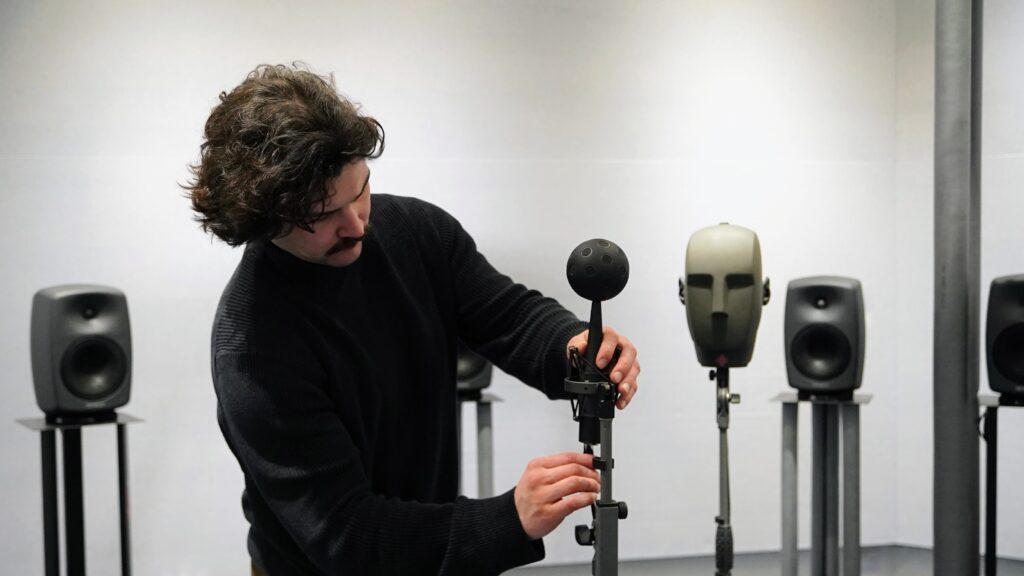OpAurEx (Optimised Auralisation Experience)


 Optimising the user experience of auralisation (OpAurEx) is a joint project between Genelec Oy and the APL of the University of Huddersfield, with a PhD student Alan Pawlak. It aims to provide experimental data and psychoacoustic principles to optimise the quality of binaural auralisation using spatial room impulse responses.
Optimising the user experience of auralisation (OpAurEx) is a joint project between Genelec Oy and the APL of the University of Huddersfield, with a PhD student Alan Pawlak. It aims to provide experimental data and psychoacoustic principles to optimise the quality of binaural auralisation using spatial room impulse responses.
Studies suggest that HRIRs measured in anechoic chambers often fail to provide convincing sound images outside the head. In contrast, binaural room impulse responses (BRIRs) captured in practical spaces can achieve externalisation more effectively as auditory distance perception is based on room reflections relative to direct sound. While BRIRs contain necessary cues for auditory localisation and spatial impression, they have limitations in practical applications such as virtual mixing rooms. These limitations include colouration, computational complexity, and localisation accuracy.
The project’s focus is investigating the role of reflections in externalisation, localisation, and colouration and finding optimal early reflection rendering methods to improve these features while maintaining high plausibility in binaural auralisation. It also encapsulates the development of a reliable framework that allows control, perceptual optimisation and evaluation of the acoustic pattern. The project outcomes have high practical implications for VR/AR applications using head and/or motion tracking.
In the first phase of the study, various spatial analysis and synthesis methods for room acoustics were reviewed. The data obtained from these methods was then used to generate synthetic BRIRs, allowing for the evaluation of the performance of each method against the original measured BRIRs. The dataset involving measurements made in an ITU-R BS.1116-compliant listening room was used to conduct a subjective study to evaluate spatial and timbral fidelities of binaural renderings. The results of the study are intended to contribute to the understanding of how existing methods and measurement setups compare to each other, and to identify best practices for the binaural synthesis of spatial room impulse responses.

The second phase of this project addresses common problems in state-of-the-art spatial analysis and synthesis methods by proposing a novel post-processing technique, Spatial Segmentation of Impulse Response (SSIR). SSIR aims to solve the problem of trailing patterns in the direction of arrival between prominent reflections in the early part of an impulse response by detecting reflections as consecutive sound events of defined length and constant direction of arrival. It is proposed as a solution for simplifying the spatial representation of the early part of a room impulse response, and as a baseline for further research in perceptual optimisation of room acoustics.
PhD project: 2020 – current, funded by Genelec and the University of Huddersfield.
Researcher: Alan Pawlak
Supervisor: Dr Hyunkook Lee
Industry supervisors (Genelec): Dr Aki Mäkivirta, Thomas Lund
Publications:
- Pawlak, A., Lee, H., Mäkivirta, A., & Lund, T. (2024) Spatial Analysis and Synthesis Methods: Subjective and Objective Evaluations Using Various Microphone Arrays in the Auralization of a Critical Listening Room, arXiv preprint arXiv:2401.15023.
- Pawlak, A., Lee, H., Mäkivirta, A., & Lund, T. (2023) Directional Analysis of Early Reflections in Small Shoebox-Shaped Listening Rooms, In Proceedings of the AES 154th International Convetion, Espoo, Finland.
- Pawlak, A., Lee, H., Mäkivirta, A., & Lund, T. (2021). Subjective evaluation of spatial analysis and synthesis methods using different microphone arrays. In 2021 Immersive and 3D Audio: from Architecture to Automotive (I3DA) (pp. 1-7). IEEE.
- Pawlak A, Lee H. Spatial Segmentation of An Early Part of The Room Impulse Response into Prominent Sound Events. In: Proceedings of the 24th International Congress on Acoustics. Gyeongju, Korea; 2022. p. 8.
